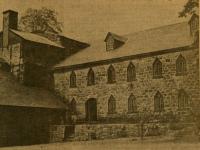Answer: Cornwall, Pa.
In the 1730s, Peter Grubb, a stone mason, discovered one of the oldest and largest iron ore deposits in America in the town of Cornwall, Pa.
Later called the Cornwall Ore Banks, it was composed of three hills: Large Iron Hill (about 58 acres), Middle Hill (about 35 acres), and Grassy Hill (about 10 acres). Grubb set about mining the ore and built Cornwall Furnace in 1742. After Grubb died in 1754, his sons Curtis and Peter inherited the furnace. During the Revolutionary War, Cornwall Furnace produced arms and armaments for American soldiers. In late October 1776, General Washington and General Lafayette personally visited the grounds to see the casting of the furnace’s first cannon.
Under the purview of the Grubb brothers, Cornwall became one of the state’s leading producers of pig iron, producing 500 tons annually by 1789. Nine years later, Robert Coleman had gained control of the furnace operation.
Cornwall operated continuously from 1742 to 1883, which made it the nation’s oldest cold blast charcoal furnace in constant use. The site was virtually abandoned after 1883 when newer furnace operations make it obsolete. However, Coleman’s great-granddaughter, Margaret Coleman Freeman Buckingham, took notice of the property decades later and gave the site to the commonwealth of Pennsylvania, along with money for its renewal, in 1932. Today, Cornwall Furnace and its grounds are a National Historic Landmark and are open to the public; and iron making demonstrations continue in the restored furnace.
Among HSP’s significant collection of forge and furnace records (#212) are many record books from Cornwall Furnace. The society also has several collections of papers from the Grubb family (#1967A, #1967B, and #1488), which further document this history of iron production in Pennsylvania.
Image: Cornwall Furnace, print from the Evening Bulletin (1940), Grubb family collection (Collection 1967A), The Historical Society of Pennsylvania.

